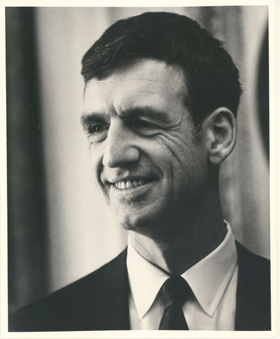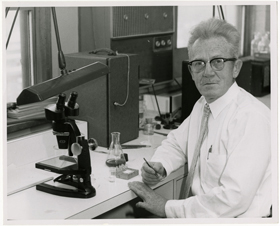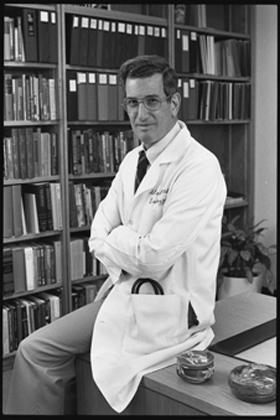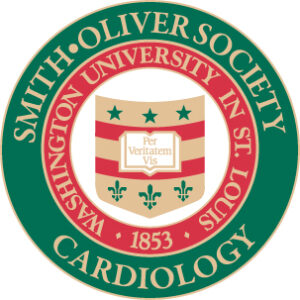Inception and early history

Historically, there were two separate sections of cardiovascular medicine at Washington University School of Medicine. The earliest program in cardiology began at Barnes Hospital (BH) in 1947. A second cardiology program emerged at Jewish Hospital (JH) in 1969. Each of these programs had separate clinical training programs, and each program developed distinct research programs that gained national prominence. With the merger of Barnes Hospital and Jewish Hospital in 1996 to form Barnes-Jewish Hospital (BJH), the two sections of cardiology united to form the current Cardiovascular Division, with a single clinical training program.
See below for historical details regarding the chiefs and acting chiefs.*

- 1947 – 1964: Dr. John R. Smith (BH)
- 1959 – 1973: Dr. John R. Smith and Dr. Brent Parker (Co-directors BH)
- 1971 – 1973: Dr. G. Charles Oliver (JH)
- 1973 – 1981: Dr. Burton Sobel (BH) and Dr. G. Charles Oliver (JH)
- 1981 – 1985: Dr. Burton Sobel (BH) and Dr. Robert E. Kleiger* (JH)
- 1986 – 1993: Dr. Burton Sobel (BH) and Dr. Louis G. Lange (JH)
- 1993 – 1994: Dr. Burton Sobel (BH) and Dr. Michael W. Rich* (JH)
- 1994 – 1997: Dr. Michael E. Cain (BH) and Dr. Samuel A. Wickline (JH)
- 1997 – 2007: Dr. Michael E. Cain (BJH)
- 2007 – 2008: Dr. Daniel P. Kelly (BJH)
- 2008 – 2009: Dr. Kenneth S. Polonsky* (BJH)
- 2009 – 2019: Dr. Douglas L. Mann (BJH)
- 2019 – 2021: Dr. Gregory Ewald (BJH)
- 2021 – Present: Dr. Sumanth D. Prabhu (BJH)
Growth of the sections of cardiology

The section of cardiology at Barnes Hospital rose to national prominence under the leadership of Burton E. Sobel, MD. The 21 year-span (1973-1994) of Dr. Sobel’s leadership was highlighted by the establishment of a Specialized Center of Research (SCOR) in Ischemic Heart Disease (1975-1995), which included studies related to enzymatic assessment of myocardial damage based on analysis of MB-CK; the Principles in Cardiovascular Research NIH T32 Training Grant (which is still in active today); and the National Research and Demonstration Center in Ischemic Heart Disease (1985-1995). Additional pioneering achievements included establishing cardiac positron emission tomography (cPET) within the CCU at Barnes Hospital, and the development of tPA as a fibrinolytic agent, which is still routinely employed in the setting of acute coronary thrombosis or cerebral thrombotic occlusion. Dr. Sobel’s work with tPA was influenced by prior seminal translational efforts of Dr. Sol Sherry, who was the chief of medicine at Jewish Hospital, and who was among the first to suggest in 1960 that thrombolytic therapy could be used for treating acute myocardial infarctions. Dr. Sobel was also responsible for recruiting Dr. Peter Corr, who performed seminal studies on the role of adrenergic stimulation and the development of lethal cardiac arrhythmias during myocardial ischemia.
Concurrently at Jewish Hospital, Louis G, Lange, MD (1986-1993), established a nationally recognized program in the Cardiology Division at Jewish Hospital in lipid absorption and metabolism resulting in key pharmacological advances by which the absorptive mechanism of lipids could be modulated. The appointment of Samuel A. Wickline at JH (1994-1997) until the merger of Barnes Hospital and Jewish Hospital to form Barnes-Jewish Hospital, had a major impact on the advancement of cardiac magnetic resonance imaging (MRI) as a clinical and research tool in cardiology. Jewish Hospital was unique in the Midwest in having a dedicated cardiac MR scanner since 1995. The nationally recognized advancements included themes of ultrasound, biomechanics and cardiovascular biophysics with support from the NIH and Whittaker Foundation in the form of a development award. These themes formed an important basis for the establishment of the Department of Biomedical Engineering at Washington University School of Engineering and Applied Science (SEAS).
Creation of the Cardiovascular Division
Barnes Hospital and Jewish Hospital merged in 1997 to form Barnes-Jewish Hospital (BJH). Michael E. Cain, MD, who was chief of cardiology at Barnes Hospital (1994-1997), was appointed to lead the newly formed Cardiovascular Division. Dr. Cain was responsible for the tremendous growth of the combined clinical programs and developing the clinical electrophysiology program at Barnes-Jewish Hospital. Dr. Cain recruited Daniel P. Kelly, MD, in 1996 to be the new Director of the Center for Cardiovascular Research (CCR).
Dr. Kelly, who was appointed as the second chief of the cardiovascular division in 2007, developed an internationally recognized research program focused on cardiac metabolism and heart failure. His laboratory focused on the gene regulatory mechanisms and cellular signaling events involved in the control of mitochondrial function, with a focus on ligand-activated nuclear receptor transcription factors that regulate cardiac metabolism.
Douglas L. Mann, MD, was recruited from Baylor College of Medicine in 2009 to become the third director of the Cardiovascular Division. Dr. Mann’s laboratory has focused on delineating the basic cellular and molecular mechanisms for heart failure, with an emphasis on how innate immunity governs tissue injury and repair in the heart. His laboratory has sought to translate these findings into novel therapeutic advances. Dr. Mann has conducted phase I clinical trials based basic on therapeutic targets identified in his laboratory, as well as served as the Principal Investigator on national and multinational phase III studies exploring novel therapeutic treatments for heart failure that arose from pre-clinical studies conducted in his laboratory.
The Cardiovascular Division today

The Cardiovascular Division at WashU Medicine continues to pursue basic, translational, and clinical research that seeks to improve the lives of patients afflicted with cardiovascular disease. The division has also emerged as one of the national leaders in the delivery of innovative, high-quality cardiovascular care to a diverse patient population.
Throughout its history, members of the Cardiovascular Division have made important contributions to our understanding of heart and vascular disease. Faculty and trainees of the division have gone on to become the president of Ecuador, chancellors and deans of medical schools, chairs of medicine, chiefs of cardiology, and leaders in the pharmaceutical industry.
In order to recognize the accomplishments of the faculty and the remarkable trainees, the division initiated the Smith-Oliver Society in 2012, to commemorate the 65th anniversary of the founding of the cardiovascular division at WashU Medicine. The society was named in honor of the first chief of cardiology at Barnes Hospital, Dr. John Smith, and the first chief of cardiology at Jewish Hospital, Dr. Charles Oliver. The goal of the society is to foster a sense of family and community among the faculty and fellows who have completed their clinical and/or research training programs at WashU Medicine.